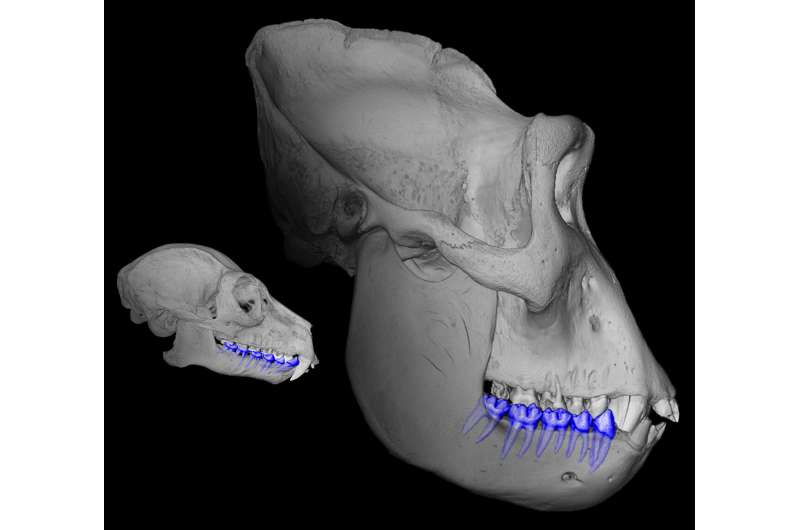Tooth root surface area can determine primate size

An often overlooked feature could give scientists new insight into the lives of ancient primate species. Researchers from North Carolina State University have developed formulas that can calculate the body size of a primate based on the root size of its teeth. The formulas could allow researchers to make use of partial and incomplete fossils in order to learn how ancient primates—including human ancestors—interacted with their environment.
Ashley Deutsch, NC State graduate student and first author of a paper describing the research, wanted to know if it was possible to determine what a primate's diet was without having the actual tooth crowns at hand—by looking instead at the roots.
What we commonly think of when we think of teeth isn't the whole story—the part that does the chewing is merely the crown. The part that keeps the tooth anchored in the jaw is the root.
"The tooth root transmits the force of the jaws into the food," says Adam Hartstone-Rose, professor of biological sciences at NC State and paper coauthor. "You can think of the root as the handle of a hammer—the handle size is related to the amount of force you can put into the hammer. So if a hammer has a small handle, it will have a small head to hammer small things. In the same way, a big tooth root can transmit more force to the tooth's crown to crush more obdurate foods."
Deutsch and the research team initially set out to determine whether tooth roots could indicate the shape of the tooth's crown, thus telling them what particular primates preferred to eat. Using computer tomography, Deutsch analyzed and calculated the tooth root surface area—or area of contact where the root fits into the jaw—of 70 primates from 75 species, ranging in size from tiny mouse lemurs to great apes.
"It was a bit like trying to figure out if you have an ax or hammer based on the shape of the handle," Deutsch says.
Ultimately, she found that the tooth roots only related to diet in a few lineages (for example, lemurs); however, she was able to determine how big the primates were across all lineages.
Deutsch developed a series of formulas based on the relationship between the tooth root surface of a molar or premolar—the teeth located between canines and molars—and primate body mass. The formulas can be used to estimate body mass of primates with more or less specificity, depending upon whether their class is known. The formulas can also explain up to 96% of variation in body mass within the examined primate sample.
But perhaps the most useful application of the equation will be with fossils that are currently of little use to anthropologists and paleontologists.
"As long as the fossil has a bit of root you can use the formulas even if the tooth crowns are missing," Deutsch says. "Fossils are often maddeningly incomplete, but now those incomplete pieces can be useful, and they could answer questions about our own lineage, like how big our ancient ancestors were."
Deutsch hopes to continue refining the existing equations and expand the work beyond primates to other mammals, including carnivores.
"Ashley has looked at something that is often preserved but also generally ignored by science and found it might hold answers to one of the most important ecological questions," Hartstone-Rose says. "Just knowing how big an animal is tells you a lot about how it interacted with the environment. And that could give us a lot of insight into our own ancient history."
The research appears as the cover article in the American Journal of Biological Anthropology.
More information: Ashley R. Deutsch et al, Primate body mass and dietary correlates of tooth root surface area, American Journal of Biological Anthropology (2021). DOI: 10.1002/ajpa.24430
Provided by North Carolina State University



















